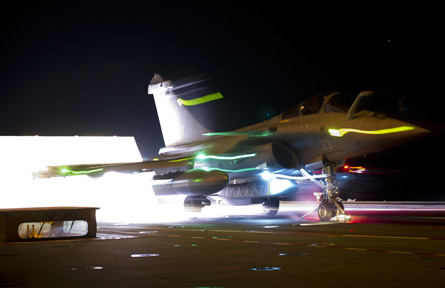For European guided weapons manufacturer MBDA, 2011 was a special year. The December celebration marking its first decade of operations came after several of its products had been used to great effect during the NATO-led campaign in Libya.
France, Italy and the UK all used Storm Shadow/Scalp EG cruise missiles during the mission to suppress pro-Gadaffi forces, while the UK also made precision strikes with the dual-mode seeker-equipped Brimstone.
 |
|---|
© Marine Nationale Scalp-EG missile were released from French Navy Rafales |
"We have only received excellent feedback about the performance, reliability and support that has been given," says chief executive Antoine Bouvier. The company's ability to meet demand for Brimstone in particular highlighted "the responsiveness and business relationship that we now have with the customer", the manufacturer adds.
TRANSFORMATION
While the 2001 formation of MBDA brought together much of the domestic missile businesses of France, Germany, Italy and the UK, it is with London and Paris that the greatest transformations have been agreed.
The UK's Team Complex Weapons construct sees MBDA head numerous companies in co-ordinating industrial activities and long-term investment against Ministry of Defence requirements. France approved a similar strategy last November, with its "Filière Missiles" programme to have an initial 10-year outlook.
A new centre of excellence model approved in February will lead to France and the UK finalising an agreed level of mutual dependence in the guided weapons sector. To be confirmed in a new treaty in 2013 or 2014, the step will lead to the nations sharing some expertise on new programmes, while retaining sovereign capability in key areas. "Either we share it, or we lose it," Bouvier notes.
While advances have been made in France and the UK, Bouvier says extending such initiatives in the company's other home nations remains a strong objective. "We are making good progress in Italy and Germany, and would look to have any collaboration with them on a case-by-case basis," he says.
Spending cuts already felt by MBDA in the UK, and expected to follow in France after the presidential election in November, place greater emphasis on the need to drive through such efficiencies. "Budgets will decline, so there is a common objective to make the best use of every euro or pound," says Bouvier, who has led the company since 2007.
With its domestic customers under such pressure, MBDA is looking to expand its export activities, with an eventual goal of achieving a 50:50 split.
The company reported revenues of just over €3 billion ($4 billion) and an orders intake of €2.6 billion in 2011, with the latter including just under €1 billion, or 32%, from export buyers.
Chief financial officer Julian Whitehead says that had a major deal to supply Mica air-to-air missiles as part of an Indian fighter upgrade been signed sooner than the first week of 2012, the sought-after orders parity would have been all but met in 2011. This absence left the company's orders backlog at €10.5 billion at year-end.
Offsets linked to the Mica deal could include the joint development and joint production of a short-range surface-to-air missile system with state-owned companies. Future sales linked to India's planned acquisition of the Dassault Rafale are likely to include arrangements with private sector companies and new joint ventures. "We are less and less an exporter of missiles, and more and more a company able to set up co-operations and partnerships," Bouvier notes.
AMBITIOUS TARGETS
The US market is also a long-held objective, and MBDA last year acquired the Viper Strike programme from Northrop Grumman. This has expanded its industrial footprint, with ownership of a small production line, but also provided a domestic hub for any design and manufacturing activities linked to lightweight weapons for unmanned air systems. But further such acquisitions will be required if the company is to achieve its ambitious business targets in the USA, given the fierce competition provided by incumbent suppliers.
Regardless of the domestic and international challenges that lie ahead, "what has been achieved over these 10 years and specifically in 2011 is the confirmation that our business model is the right one", says Bouvier. "This is the right model to grow our activities in Europe and outside Europe for the next decade."
Source: Flight International























